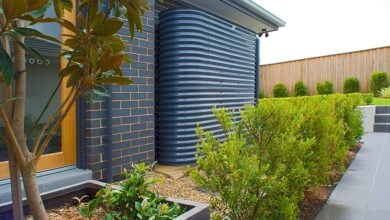Adding a deck to your property is a fantastic way to increase the amount of liveable space you have available. Plus, it encourages you to get outdoors and into your garden.
But what different types of deck materials are there? And what features do they offer? Let’s take a look.
Hardwood Deck
Some decks are made of hardwood; one of the hardiest natural options available. Hardwood has excellent resistance to weathering and infiltration by organics because of its densely-packed fibers.
Even lightly treated, it can survive outside for many years, unlike many other types of lumber that rot quickly. Furthermore, every piece of hardwood has a unique appearance given by its grain. So if you decide to make your deck from this type of wood, it’ll look unique.
One example of a hardwood deck is Jarrah decking, a naturally durable and weather-resistant timber with a long lifespan. Pacific Jarrah grows in soil with high aluminum and iron content. This Australian hardwood has distinctive brown and red tones with shades ranging from blonde to dark burgundy finish. It also has grain interlocking, wavy, or curly patterns. Moreover, Jarrah timber has gum pockets and other natural defects, adding to its overall aesthetic appeal.
While hardwood is more expensive than other decking materials, many homeowners prefer it because of the following advantages:
- Superior durability
- High quality
- Unlimited design options
- Natural look
- Fire-resistance
- Split-, warp-, and rot-resistant
Vinyl Decking
At the other end of the spectrum is vinyl deck. This isn’t made of wood at all but instead comprises a type of plastic (PVC) specifically designed for use outside.
Vinyl fencing and deck has virtually none of the vulnerabilities of wood and is a maintenance-free option for homeowners who don’t want to have to re-varnish their deck every year. It comes in many colors designed to mimic those of natural wood. And, unless you look very closely, you can’t usually tell that it’s made of plastic, however, the price is usually a little higher than wood.
Here’s a quick list of the advantages of vinyl decking:
- Easy to clean and maintain
- Durable
- Won’t rot or splinter
- Has similar aesthetic appearance as a hardwood deck
- Cheap
Composite
As the name suggests, these combine two or more materials into a single product that offers greater benefits than either could individually.
Most composite decking is made of a combination of wood and low-density polyethylene. This mix is better at withstanding weathering than regular wood but also still retains that classic, natural wooden aesthetic that many people love.
Most composites are ultra-low maintenance, meaning that you don’t usually need to refinish or re-sand them every couple of years. Some products will last up to 25 years without any requirements for intervention on your part, and they’re in a better price range.
Check the following advantages of composite decking:
- Sprinter-free
- Slip-resistant
- Easy to maintain
- Won’t disintegrate or crack
- Doesn’t have nails or screws
- The smooth surface creates a modern feel
Cedar
Cedar might be softwood, but it makes a pretty stalwart deck.
Why? It all comes down to the way the wood weathers. Unlike most softwoods, it doesn’t have the same propensity to bend, warp and rot. Instead, it decays into a gentle grey tone that’s highly resistant to environmental issues. Furthermore, natural tannins protect it from infestation, decay and infection.
Unfortunately, cedar altogether isn’t maintenance-free. You’ll still have to pressure wash and repaint it every few years or so to keep it in tip-top condition.
The advantages of cedar decking include the following:
- No need to stain
- Weather-resistant
- Sprinter-free
- Insect-resistant
- Minimum maintenance
Pressure-Treated Lumber
Traditional affordable wood deck is made of pressure-treated lumber. Here, manufacturers attempt to permeate the wood with special anti-rot chemicals using high pressure equipment.
Once the chemicals infuse into the wood, they give it more resistance to the elements while also improving its looks. Even so, you’ll still need to wash, sand and restain it regularly, as with the other organic decking options in this list.
But don’t worry, pressure-treated lumber doesn’t release any particulates or gases that could harm your family. Here are more benefits of using pressure-treated lumber for your deck:
- Easy to use
- Fire-resistant
- Insect-resistant
- Antifungal
- Moisture-resistant
- Wide variety of sizes
- Affordable
Takeaway
So with all those options, you can decide which one works best for your deck and maintenance needs. Also note, that while some products are cheaper, they’re not always built to last, so investing in quality is best.
With any deck, you want to complete it with shade to facilitate cool places to sit. Awnings on patios are the best options, and there are a variety of awnings in Salt Lake to create the perfect shade for your outdoor deck.




